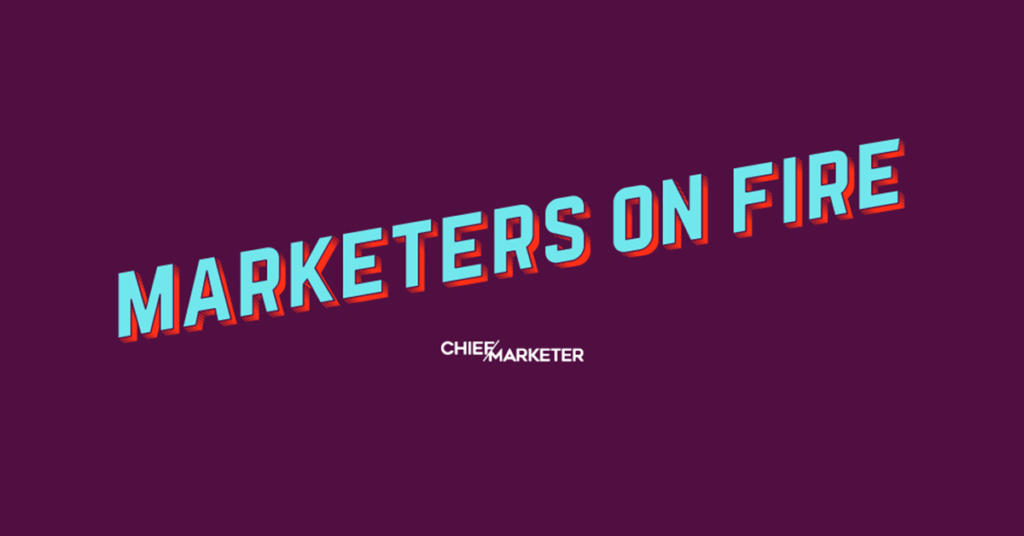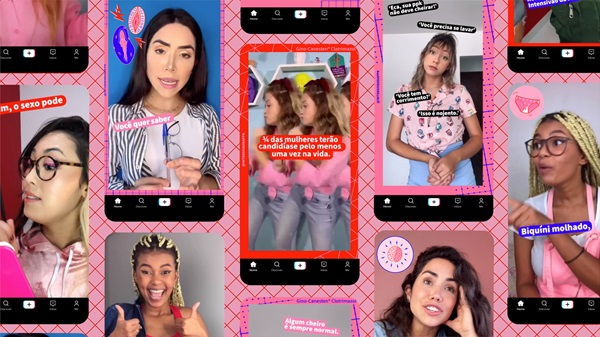Ahead of the 2022 Cannes Lions International Festival of Creativity, which activated in person last week in the south of France for the first time in three years, we picked the brain of one of the boldest risk-takers in consumer health marketing at the moment: Patricia Corsi, Global Chief Marketing & Digital Officer at Bayer Consumer Health. Tackling the taboo surrounding conversations about women’s intimate health, Corsi created an educational, entertaining, influencer- and expert-led campaign on TikTok for the global brand Canesten dubbed the “Vagina Academy.” Following is an excerpt of our conversation with Corsi about the brand’s journey through developing the campaign, its strategic marketing goals, obstacles encountered along the way—including censorship—and the importance of taking risks within the consumer health category.

Chief Marketer: How have you shown up at Cannes this year, as a marketer and with the brands you oversee?
Patricia Corsi, Global Chief Marketing & Digital Officer, Bayer Consumer Health: This has been a wonderful year for us from a creativity point of view. In the past 12 months, our brands have been recognized by numerous different awards. Cannes is always very special, and this year it was our record number of submissions. I’m very excited about that because I see the momentum from the team and in consumer health as an industry, and in our agencies as well.
Last year I had the opportunity to be a juror, not as the jury president, like this year. It was so inspiring. It was a fantastic show of creativity and greatness in this area, ideas that were outstanding in an industry that really needs this.
CM: Regarding your creative campaigns, you’ve been working on incorporating science into them. Can you talk about that?
PC: This is an area in health that has been a big challenge for the creative industry for many years, but we also have to recognize that most of the consumer health companies come as divisions of pharma companies, which are not well known for being strong in brand building and brand development.
The first step was to understand that having [great] science is non-negotiable. And then, the regulations are there for a good reason, because it’s not like other categories. When something goes wrong, people’s lives are at stake. But this shouldn’t stop us. I think that the best ideas normally come when we have constraints, and [know] when to be clear, what the boundaries are and then move forward.
CM: Tell me about the Creative Council you formed and how it informs your campaigns.
PC: The Creative Council is a forum with our strategic partners. We have key marketers in each one of our regions, and then we have CMOs and digital officers from external, noncompetitive companies like Danone, Dole, Google, et cetera. It started with a very simple idea: collaboration and learning from each other is the only path forward. Everyone put their time in pro bono, because we want to make a change in the industry—not just for Bayer. And of course, the things that we discussed there will help inspire other CMOs from a consumer-centric point of view and help our partners better understand this industry and the challenges [faced by] other countries and partners.
We’ve had quarterly meetings, for almost two years, and we focus on a couple of strategic topics. For example, how do we use data to drive creativity? Another strategic topic would be marketing for good. There is one that we are implementing now in Brazil that is something that we want to change systemically—the lack of diversity in the advertising industry. We partner with the Creative Club (the Brazilian version of the ANA in the U.S.) and we have a contest for people who aim to be in the creative business who come from low-income households, and specifically for the black community. They will have the chance to work on briefings for our brands, and the ones who win will get mentoring from the best creative directors in Brazil, as well as exclusive training that will put them in a competitive situation versus people that have a lot of means, contacts, family connections, et cetera.
CM: The Vagina Academy campaign in Brazil, from the women’s intimate health brand Canesten, is taboo-busting, to put it lightly. What was the inspiration behind it?
PC: This is one that is very close to my heart because it came from a program that we have called Creative Unleashed, something that I started doing when I was working for Heineken. Our agencies have forums throughout the year where they can come and present great ideas for our brands, without any briefing, just out of passion for our brands. And Vagina Academy came from one of those forums.
The initial reaction internally was, oh, we love this, because it’s [really] the job of this brand. But can we just take the vagina name out of it? It was really funny. The agency almost fell out of their chairs, because, of course, if you take the vagina name of it, it loses most of its power.
But it was a great opportunity. This is not an industry that has been educated on risky, bold communication ideas. It was a great learning opportunity for everyone in the process, which I really embraced.
CM: What consumer insights did you base the campaign on?
PC: We started with data and it was telling us the following: Women’s intimate health is a real issue. When women have a problem, they feel ashamed. They feel people are judging them. They feel people are saying that they’re promiscuous, so they don’t tell anyone when they have intimate problems, including their doctors. That should be the most sacred relationship you have for your health, right? If you cannot talk to a gynecologist, who are you going to talk to?
We discovered in a couple of countries that, on average, 70 percent of the women would not say the word “vagina” to their gynecologist—someone who has studied this word and this organ, back and forth, inside and out. This was the first piece of data. The second one was more observing consumer behavior and looking at how we can help. We observed that when women got in front of the shelf to buy products for intimate health problems, it was like a pitstop in Formula One or NASCAR, because they were so worried that someone would see them buying that product. And most of the time, they would buy the wrong product, because they were not even reading it.
It is not a simple category to understand. One of the consumers said, “I would find anything that has a flower on it, and I would buy it,” because a flower is a gentle way of saying vagina. I found that hilarious. But on the other hand, poor lady! Did it solve her problem? The answer is no, because of course she bought [the wrong thing.] We looked at that and we said the only way that we are going to help them is by democratizing the discussion about vagina health and making it mainstream.
CM: Did you face any opposition from the Brazilian community for shining a light on a taboo topic?
PC: We started facing problems that we never thought we would have. The wonderful thing is that the Brazilian team really bought into the idea. You want a country that is going to lead [a campaign] to be into it. There are so many working women in Brazil that they felt the responsibility to do something to help.
We wanted to do this in a super organic, democratic, modern way. So where are we going to go? TikTok. We go to TikTok, and TikTok loves it. We said we are going to have lots of different influencers and physiotherapists for vagina health. We had people who really knew what they were talking about.
But then TikTok came to us and said, oh, there is one small problem. The word vagina is censored on TikTok. So, how are we going to do a program that is called Vagina Academy when the word is censored? This is where I go back to what I mentioned to you before: Collaboration gets us further. We worked with our agency partner, TikTok and our team in Brazil and we managed to uncensor the word.
This was also a great opportunity to show that we respect diversity. At that point, we had just joined the Unstereotype Alliance from the United Nations. We made sure that all different women in Brazil felt represented, all the different ethnicities, women with physical disabilities. We had a great representation of women, different ages, et cetera. We delivered the equivalent of 17,000 classes on intimate health. There was no program in the country that has done that.
These are the type of things that when you come to health you want to do, but you are always afraid that something’s going to block you. It started as a use case in Brazil, and now it’s in Europe, Asia Pacific, and each different country is putting their nuance into it. For example, in Australia, it’s called the University of Down Under. In Italy, they have managed together with Meta to uncensor “vagina” on Facebook. Every single country that we go to, we look back and see that we are making a difference. It’s a shame that we don’t have this brand and this product in the U.S., because it would be a no-brainer to democratize women’s intimate health there.
CM: Who enrolls in this? Are you targeting all female consumers?
PC: This is a great question, because the answer is quite tricky. Our target is expanding in this way versus how it started. We started in a very traditional way with women who look like women and were born like women, from age 15 to maybe 45. And now it’s changing a little bit. The trans community was something that we hadn’t had in our thoughts. We are learning how to cater to them.
So, how do we do it in a way that is also inclusive to them? We don’t have the answer yet. But just last week, a very generous person from our team in one of the countries who is a transgender had a conversation with me to help me educate myself and to talk about the challenges and problems, and it was wonderful session. I’m very grateful that there are people who are really willing to stop what they’re doing to help me to learn more. And with that, [we’ll] be able to serve them better.
CM: Beyond the personal passion that you have for this topic, what are the strategic marketing goals of this campaign? What’s the business objective?
PC: We want to continue to consolidate our brand preference and our brand loyalty. Second, we want to increase the level of experience with our products. This goes back to the point that people were not staying long enough in front of the shelf to buy the right product. How do we come across from a packaging design point of view, so people know what to look for? The consumer experience with our brands goes from shelf to usage at home.
And of course, brand equity over time—more than just short-term gains. In all the countries where we have implemented this, we have grown market share. As important as growing market share is our ability to increase brand love and brand equity through time, because we believe there is an opportunity for us to serve women’s intimate health, even further than what we are doing at the moment.
CM: In terms of platforms you use to market this campaign to consumers, are you going beyond TikTok to reach people?
PC: We use different platforms in different countries. In Italy, we have Meta. In Brazil, we had TikTok, and a lot of the influencers also put the same content in Instagram. But the most important strategic channel decision is that it was not going to be a campaign in the traditional media [sense]. We also did a lot of direct and ambient out of home.
It wasn’t a PR stunt, but in Brazil, for example, we had a bus going up to the favelas—the low-income places—to deliver these educational classes. And in the UK, we are also approaching the educational system on how to change the way intimate health is taught to adolescents, to teenagers in school. Each country has a different way of executing the principles. But the strategic principles are all the same. We want to use media that is in line with the people who we are talking to—and this means non-traditional media.
The second thing is that there is an over-index on education versus product selling. There are lots of things where, as a portfolio, we don’t have an offer. Nevertheless, even if we don’t have an offering from a product or service point of view, we believe by partnering with women on their needs we’ll increase their love for the brand, their loyalty and brand equity. And in some countries, we have started to test telehealth and use bots. Because we know that this is a taboo topic, there are a couple of questions on intimate health that are very easily responded to by bots, to help tackle [the fact that] some people still feel ashamed. We are also testing some solutions in the digital world.
CM: Speaking more generally, what are a couple of trends that global marketers should be keeping an eye on today?
PC: The first one is looking at data to drive insights and creativity. The second one is the power of collaboration. In the past, there was a tendency to integrate with one partner as the solution. The last one is the opportunity that digital transformation brought to marketers—the ability to test and try things. When I started my career, there was not a lot of space to try things, because if you do something wrong on a TV ad, or a print or radio ad, you lost the whole thing. The risk was so big. Now, with digital, there’s A/B testing, understanding how the consumer feels about different messages, personalization, precision and programmatic. I think there is this great opportunity to be more courageous and to take a little bit more risk, specifically in health.
Of course, I’m not talking about regulatory risk. I’m talking about creative risks. Sometimes the default expectation is that everyone in the room will like an idea—and that that’s the best idea. I tend to think that if everyone thinks that one idea is good, we are missing something. The best ideas for me are the ones where you really want to hate it, but you love it, and you feel uncomfortable with it. It makes your heart beat.
Now, I see a great opportunity to do this more with business focus. A couple of years back, we had a wave of brilliant creativity. But they did nothing for company results. I think it’s the combination of creativity that has stopping power with consumers and driving business results. It is what gives us credibility and continues assurance from the business to continue doing the things that we can do best. The trend of the Chief Marketing Officer or marketing head as just an expert in advertising is long gone.






 Network
Network

